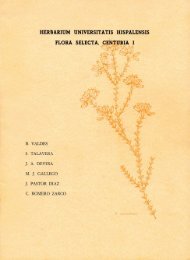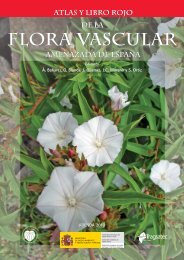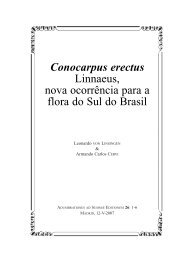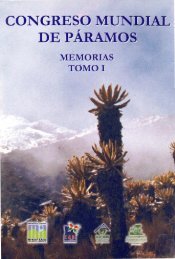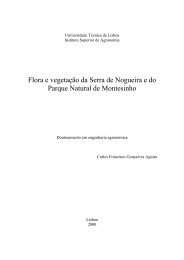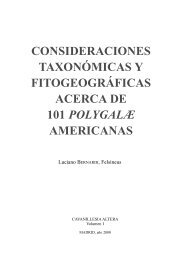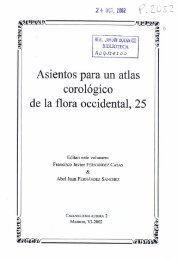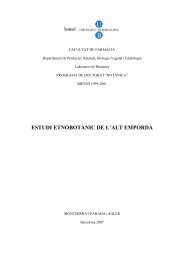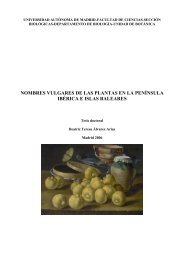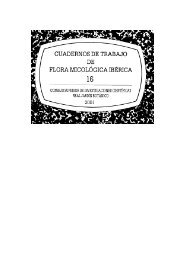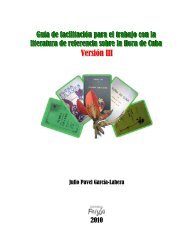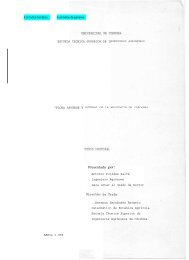- Page 1:
Universidad Autónoma de Madrid Fac
- Page 5:
AGRADECIMIENTOS Este trabajo es un
- Page 8 and 9:
ABSTRACT The direct interrelation b
- Page 10 and 11:
X Especies con nombre y sin uso ...
- Page 12 and 13:
BIBLIOGRAFÍA .....................
- Page 15 and 16:
1.1 Presentación 1. Introducción
- Page 17 and 18:
1. Introducción En este proceso de
- Page 19 and 20:
1. Introducción Marsh 1994; Heinri
- Page 21 and 22:
1. Introducción A lo largo del tra
- Page 23:
2. ZONA DE ESTUDIO
- Page 26 and 27:
Estudio etnobotánico y agroecológ
- Page 28 and 29:
Estudio etnobotánico y agroecológ
- Page 30 and 31:
Estudio etnobotánico y agroecológ
- Page 32 and 33:
Estudio etnobotánico y agroecológ
- Page 34 and 35:
Estudio etnobotánico y agroecológ
- Page 36 and 37:
Estudio etnobotánico y agroecológ
- Page 38 and 39:
Estudio etnobotánico y agroecológ
- Page 40 and 41:
Estudio etnobotánico y agroecológ
- Page 42 and 43:
Estudio etnobotánico y agroecológ
- Page 44 and 45:
Estudio etnobotánico y agroecológ
- Page 46 and 47:
Estudio etnobotánico y agroecológ
- Page 48 and 49:
Estudio etnobotánico y agroecológ
- Page 50 and 51:
Estudio etnobotánico y agroecológ
- Page 53 and 54:
3.1 Introducción 3. Catálogo etno
- Page 55 and 56:
3. Catálogo etnobotánico realizad
- Page 57 and 58:
3. Catálogo etnobotánico Municipi
- Page 59 and 60:
3.2.2 Recogida de los datos 3. Cat
- Page 61 and 62:
3. Catálogo etnobotánico Una entr
- Page 63 and 64:
3. Catálogo etnobotánico observó
- Page 65 and 66:
3. Catálogo etnobotánico Se trata
- Page 67 and 68:
Categorías de uso y saberes 3. Cat
- Page 69 and 70:
3.2.4 Tratamiento y análisis de lo
- Page 71 and 72:
Nombre científico 3. Catálogo etn
- Page 73 and 74:
3. Catálogo etnobotánico bien por
- Page 75 and 76:
3. Catálogo etnobotánico En el an
- Page 77 and 78:
3.3 Resultados PTERIDOFITAS Dryopte
- Page 79 and 80:
volver, se le tapan los ojos y se l
- Page 81 and 82:
Obtención: recolectada Municipios:
- Page 83 and 84:
APIACEAE Foeniculum vulgare subsp.
- Page 85 and 86:
nos contaron que esta especie resul
- Page 87 and 88:
ASTERACEAE Bidens aurea (Aiton) She
- Page 89 and 90:
malva, orégano, anises y manzanill
- Page 91 and 92:
Usos ORNAMENTAL - Flor cortada o se
- Page 93 and 94:
ORNAMENTAL - Patios, huertos y jard
- Page 95 and 96:
Figura 3-8. Té (Jasonia tuberosa)
- Page 97 and 98:
ASTERACEAE Onopordum illyricum L. s
- Page 99 and 100:
ASTERACEAE Senecio jacobaea L. LA14
- Page 101 and 102:
Usos ALIMENTACIÓN ANIMAL - Forraje
- Page 103 and 104:
ALIMENTACIÓN - Legumbres y hortali
- Page 105 and 106:
Saberes LÉXICO - Refranes y cancio
- Page 107 and 108:
CAPRIFOLIACEAE Sambucus ebulus L. L
- Page 109 and 110:
CARYOPHYLLACEAE Dianthus caryophyll
- Page 111 and 112:
ALIMENTACIÓN ANIMAL - Forraje o pi
- Page 113 and 114:
caliente. La jara se cría en solan
- Page 115 and 116:
prepararlo primero se calentaba el
- Page 117 and 118:
comerlos es en tortilla o revuelto.
- Page 119 and 120:
Obtención: cultivada Municipios: 1
- Page 121 and 122:
mucho trabajo sacarlas. - Encendido
- Page 123 and 124:
INDUSTRIA Y ARTESANÍA - Escobas (9
- Page 125 and 126:
Usos COMBUSTIBLES - Chamuscar al go
- Page 127 and 128:
Municipios: 2, 1* Informantes: 2, 1
- Page 129 and 130:
Phaseolus vulgaris L. FABACEAE 3051
- Page 131 and 132:
FABACEAE Trifolium pratense subsp.
- Page 133 and 134:
Vicia sepium L. LA574 Alverjana (1)
- Page 135 and 136:
las palas con las que se daba la vu
- Page 137 and 138:
Usos ORNAMENTAL - Flor cortada o se
- Page 139 and 140:
En Villavieja dicen de la madera de
- Page 141 and 142:
Mentha spicata L. LA56, LA83, LA395
- Page 143 and 144:
omero en un caldero de cobre, que s
- Page 145 and 146:
MEDICINA - Aparato respiratorio (3)
- Page 147 and 148:
Manejo Los linares reciben su nombr
- Page 149 and 150: Moral (2), morón (1) Obtención: c
- Page 151 and 152: cultivos de garbanzos para proteger
- Page 153 and 154: santos en la Virgen de Fátima, San
- Page 155 and 156: POLYGONACEAE Rumex acetosella L. su
- Page 157 and 158: otras hierbas silvestres, salvado,
- Page 159 and 160: fueran pipas”, principalmente los
- Page 161 and 162: ROSACEAE Malus sylvestris (L.) Mill
- Page 163 and 164: Obtención: cultivada, recolectada
- Page 165 and 166: almíbar. INDUSTRIA Y ARTESANÍA -
- Page 167 and 168: Rubus lainzii H.E. Weber Zarza garr
- Page 169 and 170: Usos ALIMENTACIÓN - Bebidas (1): E
- Page 171 and 172: Populus nigra L. LA341, LA622, LA64
- Page 173 and 174: muy esparramá, pero tiene los tall
- Page 175 and 176: Figura 3-22. Atando escoba de algar
- Page 177 and 178: aprovechaban para hacer conservas e
- Page 179 and 180: matar a los peces. Su alta toxicida
- Page 181 and 182: - Aparato respiratorio (1). Anginas
- Page 183 and 184: Municipios: 2 Informantes: 2 Vigenc
- Page 185 and 186: IRIDACEAE Crocus carpetanus Boiss.
- Page 187 and 188: que cuando se cosechan las cebollas
- Page 189 and 190: LILIACEAE Hyacinthoides hispanica (
- Page 191 and 192: Orchis mascula L. LA408, LA436 Clav
- Page 193 and 194: Hordeum vulgare L. LA732, LA733 Ceb
- Page 195 and 196: paladar al ojo. De esta forma se qu
- Page 197 and 198: de Casla y Prádena, y con los muni
- Page 199: Usos ALIMENTACIÓN - Silvestres com
- Page 203 and 204: 191 Quercus pyrenaica Fraxinus angu
- Page 205 and 206: 3. Catálogo etnobotánico como com
- Page 207 and 208: Categorías de uso 3. Catálogo etn
- Page 209 and 210: 3. Catálogo etnobotánico Aunque l
- Page 211 and 212: 3. Catálogo etnobotánico El órga
- Page 213 and 214: 3. Catálogo etnobotánico activida
- Page 215 and 216: 3. Catálogo etnobotánico Por otro
- Page 217 and 218: 205 FAMILIA Nombre científico Nomb
- Page 219 and 220: 207 FAMILIA Nombre científico Nomb
- Page 221 and 222: 209 FAMILIA Nombre científico Nomb
- Page 223 and 224: 3. Catálogo etnobotánico Entre la
- Page 225 and 226: 3. Catálogo etnobotánico El uso d
- Page 227 and 228: 3. Catálogo etnobotánico Las ros
- Page 229 and 230: 3. Catálogo etnobotánico silvestr
- Page 231 and 232: 3. Catálogo etnobotánico sólo un
- Page 233 and 234: Especies cultivadas y compradas 3.
- Page 235 and 236: FAMILIA Nombre científico Nombre v
- Page 237 and 238: FAMILIA Nombre científico Nombre v
- Page 239 and 240: 3. Catálogo etnobotánico Tabla 3-
- Page 241 and 242: FAMILIA Nombre científico Nombre v
- Page 243 and 244: FAMILIA Nombre científico Nombre v
- Page 245 and 246: 233 Quercus pyrenaica Fraxinus angu
- Page 247 and 248: FAMILIA Nombre científico Nombre v
- Page 249 and 250: 3. Catálogo etnobotánico A) Alime
- Page 251 and 252:
239 Tabla 3-14. Vegetales y hong
- Page 253 and 254:
241 FAMILIA Nombre científico Nomb
- Page 255 and 256:
243 FAMILIA Nombre científico Nomb
- Page 257 and 258:
245 FAMILIA Nombre científico Nomb
- Page 259 and 260:
247 FAMILIA Nombre científico Nomb
- Page 261 and 262:
249 TILIACEAE Tilia cordata (cu) ti
- Page 263 and 264:
Especies 3. Catálogo etnobotánico
- Page 265 and 266:
IC 3. Catálogo etnobotánico se ha
- Page 267 and 268:
3. Catálogo etnobotánico la medic
- Page 269 and 270:
Jarabe Machacar 3% 2% Calentar Frei
- Page 271 and 272:
3. Catálogo etnobotánico Hojas y
- Page 273 and 274:
3.4.5 Veterinaria popular 3. Catál
- Page 275 and 276:
263 FAMILIA Nombre científico Nomb
- Page 277 and 278:
265 FAMILIA Nombre científico Nomb
- Page 279 and 280:
267 FAMILIA Nombre científico Nomb
- Page 281 and 282:
IC 3. Catálogo etnobotánico lavad
- Page 283 and 284:
3. Catálogo etnobotánico los musg
- Page 285 and 286:
3. Catálogo etnobotánico La forma
- Page 287 and 288:
Aparato reproductor 3. Catálogo et
- Page 289 and 290:
3.4.6 La selección de plantas silv
- Page 291 and 292:
3. Catálogo etnobotánico y suroes
- Page 293 and 294:
3. Catálogo etnobotánico En las e
- Page 295 and 296:
3. Catálogo etnobotánico distingu
- Page 297:
4. MANEJO DE LOS AGROECOSISTEMAS
- Page 300 and 301:
4.2 Metodología El manejo de los a
- Page 302 and 303:
Recogida y organización de los dat
- Page 304 and 305:
Los huertos familiares actuales se
- Page 306 and 307:
Tabla 4-3. Lista de municipios e in
- Page 308 and 309:
Tabla 4-5. Formulario sobre la pers
- Page 310 and 311:
Organización de los datos Los dato
- Page 312 and 313:
(Montero et al. 1998). Este muro ta
- Page 314 and 315:
Poda y ramoneo En las zonas de mont
- Page 316 and 317:
como forraje invernal. Se guardaba
- Page 318 and 319:
cubriéndolo con tierra. La faja ev
- Page 320 and 321:
En otoño se iba bajando a pastos d
- Page 322 and 323:
En Puebla de la Sierra se recolecta
- Page 324 and 325:
la cárcel. Con eso tol mundo con l
- Page 326 and 327:
Figura 4-3. Foto aérea del 7 de oc
- Page 328 and 329:
ganado, principalmente vacas en la
- Page 330 and 331:
Especies cultivadas En la Tabla 4-9
- Page 332 and 333:
julio o principios de agosto. Las b
- Page 334 and 335:
una cuota. En algunos casos, como P
- Page 336 and 337:
segar, porque venía un airazo o un
- Page 338 and 339:
en Valdemanco, pero no cernían, as
- Page 340 and 341:
Linares Los linares son otro tipo d
- Page 342 and 343:
Manejo del suelo En el manejo tradi
- Page 344 and 345:
sistema de regueras, por lo que só
- Page 346 and 347:
En general el riego se retrasaba ha
- Page 348 and 349:
Destino de la producción La finali
- Page 350 and 351:
338 Usos Especie/ Variedad Nombre l
- Page 352 and 353:
340 ♦ Especies más productivas y
- Page 354 and 355:
similares son el trigo, la cebada o
- Page 356 and 357:
De otras especies, como la patata,
- Page 358 and 359:
espondieron que también habían ap
- Page 360 and 361:
los huertos, furgonetas reconvertid
- Page 362 and 363:
para quitar hierbas fuertes. Tambi
- Page 364 and 365:
Los semilleros se realizan en la mi
- Page 366 and 367:
los huertos se dedicaba casi toda l
- Page 368 and 369:
También se exponen en la Tabla 4-1
- Page 370 and 371:
con ellas. Otro tipo de calabazas c
- Page 372 and 373:
Junto a éstas aparecen especies cu
- Page 374 and 375:
362 JUDÍAS- MAÍZ En las huertas d
- Page 376 and 377:
• Toleradas: Aquellas que resulta
- Page 378 and 379:
366 Figura 4-33. Perfil con la dist
- Page 380 and 381:
Estudio etnobotánico y agroecológ
- Page 382 and 383:
Estudio etnobotánico y agroecológ
- Page 384 and 385:
Estudio etnobotánico y agroecológ
- Page 386 and 387:
Estudio etnobotánico y agroecológ
- Page 388 and 389:
Estudio etnobotánico y agroecológ
- Page 390 and 391:
Estudio etnobotánico y agroecológ
- Page 392 and 393:
Estudio etnobotánico y agroecológ
- Page 394 and 395:
Estudio etnobotánico y agroecológ
- Page 396 and 397:
Estudio etnobotánico y agroecológ
- Page 398 and 399:
386
- Page 401 and 402:
5.1 Introducción 5. Cultivos y var
- Page 403 and 404:
5. Cultivos y variedades tradiciona
- Page 405 and 406:
5. Cultivos y variedades tradiciona
- Page 407 and 408:
Tabla 5-2. Formulario de varieda
- Page 409 and 410:
Frutales 5. Cultivos y variedades t
- Page 411 and 412:
5. Cultivos y variedades tradiciona
- Page 413 and 414:
5. Cultivos y variedades tradiciona
- Page 415 and 416:
5. Cultivos y variedades tradiciona
- Page 417 and 418:
5. Cultivos y variedades tradiciona
- Page 419 and 420:
5. Cultivos y variedades tradiciona
- Page 421 and 422:
Berza forrajera 5. Cultivos y varie
- Page 423 and 424:
de tardido echa más”. 5. Cultivo
- Page 425 and 426:
a 5. Cultivos y variedades tradicio
- Page 427 and 428:
5. Cultivos y variedades tradiciona
- Page 429 and 430:
5. Cultivos y variedades tradiciona
- Page 431 and 432:
Lechuga oreja de mula 5. Cultivos y
- Page 433 and 434:
5. Cultivos y variedades tradiciona
- Page 435 and 436:
5. Cultivos y variedades tradiciona
- Page 437 and 438:
Patata (Solanum tuberosum) 5. Culti
- Page 439 and 440:
5. Cultivos y variedades tradiciona
- Page 441 and 442:
Uso: En ensalada. 5. Cultivos y var
- Page 443 and 444:
Remolacha forrajera (Beta vulgaris
- Page 445 and 446:
a b c 5. Cultivos y variedades trad
- Page 447 and 448:
5. Cultivos y variedades tradiciona
- Page 449 and 450:
5. Cultivos y variedades tradiciona
- Page 451 and 452:
5. Cultivos y variedades tradiciona
- Page 453 and 454:
5. Cultivos y variedades tradiciona
- Page 455 and 456:
Manejo: Se multiplica por renuevo.
- Page 457 and 458:
5. Cultivos y variedades tradiciona
- Page 459 and 460:
5. Cultivos y variedades tradiciona
- Page 461 and 462:
5. Cultivos y variedades tradiciona
- Page 463 and 464:
5. Cultivos y variedades tradiciona
- Page 465 and 466:
5. Cultivos y variedades tradiciona
- Page 467 and 468:
Nombre: Ciruela verdal (3). Municip
- Page 469 and 470:
Guindo (Prunus cerasus, Prunus x go
- Page 471 and 472:
5. Cultivos y variedades tradiciona
- Page 473 and 474:
Nombre: Maíllas blancas (5). Munic
- Page 475 and 476:
5. Cultivos y variedades tradiciona
- Page 477 and 478:
Vigencia: Sólo localizamos un ejem
- Page 479 and 480:
5. Cultivos y variedades tradiciona
- Page 481 and 482:
5. Cultivos y variedades tradiciona
- Page 483 and 484:
5. Cultivos y variedades tradiciona
- Page 485 and 486:
5. Cultivos y variedades tradiciona
- Page 487 and 488:
5. Cultivos y variedades tradiciona
- Page 489 and 490:
5. Cultivos y variedades tradiciona
- Page 491 and 492:
5. Cultivos y variedades tradiciona
- Page 493 and 494:
5. Cultivos y variedades tradiciona
- Page 495 and 496:
5. Cultivos y variedades tradiciona
- Page 497 and 498:
5. Cultivos y variedades tradiciona
- Page 499 and 500:
5. Cultivos y variedades tradiciona
- Page 501 and 502:
5. Cultivos y variedades tradiciona
- Page 503 and 504:
5. Cultivos y variedades tradiciona
- Page 505 and 506:
5. Cultivos y variedades tradiciona
- Page 507 and 508:
5. Cultivos y variedades tradiciona
- Page 509 and 510:
Judías Caretas Uso: Grano seco y v
- Page 511 and 512:
5. Cultivos y variedades tradiciona
- Page 513 and 514:
Judía de la Virgen 5. Cultivos y v
- Page 515 and 516:
5. Cultivos y variedades tradiciona
- Page 517 and 518:
5. Cultivos y variedades tradiciona
- Page 519 and 520:
5. Cultivos y variedades tradiciona
- Page 521 and 522:
Boletes 5. Cultivos y variedades tr
- Page 523 and 524:
Semilla: Arriñonada, semi-llena, c
- Page 525 and 526:
Judión (Phaseolus coccineus) 5. Cu
- Page 527 and 528:
5. Cultivos y variedades tradiciona
- Page 529 and 530:
Trigo (Triticum aestivum) 5. Cultiv
- Page 531 and 532:
5. Cultivos y variedades tradiciona
- Page 533 and 534:
5.4 Discusión 5.4.1 Análisis del
- Page 535 and 536:
8% 37% 4% 4% 2% 45% 5. Cultivos y v
- Page 537 and 538:
Color 5. Cultivos y variedades trad
- Page 539 and 540:
Tipo de crecimiento 5. Cultivos y v
- Page 541 and 542:
Sabor Productividad Textura Caldo M
- Page 543 and 544:
5. Cultivos y variedades tradiciona
- Page 545 and 546:
5. Cultivos y variedades tradiciona
- Page 547 and 548:
5. Cultivos y variedades tradiciona
- Page 549 and 550:
5. Cultivos y variedades tradiciona
- Page 551:
6. CONCLUSIONES
- Page 554 and 555:
Estudio etnobotánico y agroecológ
- Page 557 and 558:
Bibliografía Abu-Rabia, A. (1999).
- Page 559 and 560:
Bibliografía basis for sustainable
- Page 561 and 562:
Bibliografía Bonet, M.A., M. Parad
- Page 563 and 564:
Bibliografía Chadwick, D. & J. Mar
- Page 565 and 566:
Bibliografía Espejo-Ibáñez, M.C.
- Page 567 and 568:
Bibliografía García Jiménez, F.S
- Page 569 and 570:
Laboratory, Beltsville, Maryland. U
- Page 571 and 572:
Bibliografía Huffman, M.A. (2002).
- Page 573 and 574:
Bibliografía diversity: 109-142. L
- Page 575 and 576:
Bibliografía Montoya Oliver, J.M.
- Page 577 and 578:
Bibliografía Phillips, O. & A.H. G
- Page 579 and 580:
Bibliografía Rivas Martínez, S. (
- Page 581 and 582:
Bibliografía Soriano Niebla, J.J.
- Page 583 and 584:
Bibliografía Vallès, J., M.A. Bon
- Page 585 and 586:
Bibliografía Vogl-Lukasser, B., C.
- Page 587:
ANEXOS
- Page 590 and 591:
Estudio etnobotánico y agroecológ
- Page 592 and 593:
Estudio etnobotánico y agroecológ
- Page 594 and 595:
Estudio etnobotánico y agroecológ
- Page 596 and 597:
Estudio etnobotánico y agroecológ
- Page 598 and 599:
Estudio etnobotánico y agroecológ
- Page 600 and 601:
Estudio etnobotánico y agroecológ
- Page 602 and 603:
590
- Page 605 and 606:
Índice de figuras Índices de figu
- Page 607 and 608:
Índices de figuras y tablas Figura
- Page 609 and 610:
Índice de tablas Índices de figur



